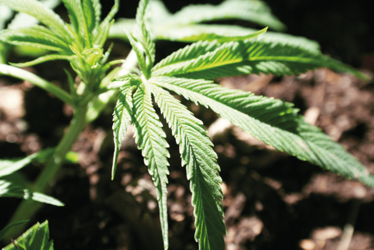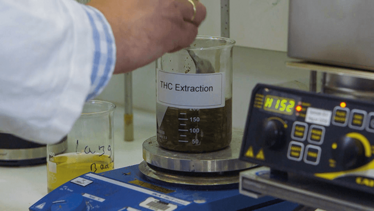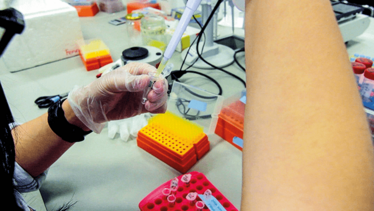A Career in Cannabinoids
The complexities of the cannabis plant have made it a fascinating research target for years. And Roger Pertwee is one of the most prolific researchers in the field.
Roger Pertwee, Emeritus Professor at the University of Aberdeen, UK, and Director of Pharmacology at GW Pharmaceuticals, has spent 50 years studying the pharmacology of cannabinoids and made major contributions to the field, including the co-discovery of the first endocannabinoid – anandamide – and thus the endocannabinoid system. He is a co-founder of the International Cannabinoid Research Society and has received numerous awards for his work, including the 2011 Wellcome Gold Medal by the British Pharmacological Society.
How did you first become interested in pharmacology?
I was reading for a degree in biochemistry at the University of Oxford where the Head of Department was the famous scientist, Hans Krebs. During that time, I joined the OU Officer’s Training Corps (Royal Engineers), which gave me the opportunity to spend a couple of weeks at Marchwood, near Southampton, to undergo training as an army shallow water diver. As a result, I became aware of the phenomenon of inert gas narcosis (“raptures of the deep”) – early signs of general anesthesia that can be induced by compressed air when inhaled by a diver at certain depths. I was intrigued by this then little-investigated phenomenon to the extent that once I had obtained my degree (in the summer of 1965), I approached the Royal Naval Physiological Laboratory at Portsmouth for advice on how I might begin research into inert gas narcosis. I was directed back to Oxford – to Professor Bill Paton, Head of the Department of Pharmacology and a world-renowned expert on the pharmacology of anesthetics. He took me on as a student in October 1965.


And how did you come to focus on cannabinoids?
Around the time I was carrying out my DPhil research, cannabis had just emerged in the UK as a significant recreational drug, prompting the need for research to investigate its then largely unexplored pharmacology. Since the constituents of cannabis were known to be very lipid-soluble, Paton was interested in investigating the possibility that one or more of these constituents might affect brain function (for example, to produce a “high”) by acting like a general anesthetic (at a sub-anesthetic dose) potentially by affecting the “fluidity” of cell membranes. Because I had been working on the pharmacology of general anesthesia for my DPhil, Paton took me on as a post-doctoral research assistant to work on the pharmacology of cannabis and some of its constituents. I was very lucky to enter what turned out to be a fascinating field of research, at a time when so little was known about cannabinoid pharmacology.
What challenges have you faced in the field?
There is a good system in place in the UK for obtaining a license that allows a scientist to perform valid research with cannabinoids, so there haven’t been any regulatory hurdles. One challenge I have faced, however, was the fading interest in cannabinoid pharmacological research in the mid/late 1980s – many felt, at the time, that there was nothing new that needed to be, or could be, learned about cannabis. However, all that changed with the discovery of cannabinoid receptors – and the cloning of the CB1 receptor in 1990 – along with the subsequent discovery, in 1992, that we humans produce cannabinoids (endocannabinoids) in our own bodies that can activate cannabinoid receptors. The first of these endocannabinoids, anandamide, was discovered, partly in my lab, in a project led by Raphael Mechoulam, and generated important new reasons for carrying out cannabinoid research.

A sample of cannabinoid-related discoveries made by Roger Pertwee and colleagues
- The development of new bioassays for exploring the pharmacology of cannabinoids.
- The co-discovery of anandamide and the endocannabinoid system – an important potential therapeutic target.
- The discovery of an allosteric site on the cannabinoid CB1 receptor.
- The discovery of some of the pharmacological actions of certain chemicals (phytocannabinoids) present in cannabis, and hence of new potential therapeutic uses for some of these compounds – for example, the elucidation of the mechanisms of action and unique therapeutic potential of delta-9-tetrahydrocannabivarin (THCV) and of cannabidiolic acid (CBDA).
- Contributing to the eventual development of a cannabis-based medicine (Sativex) for multiple sclerosis (MS) – first, by interacting in the 1990s with MS patients who were self-medicating with cannabis, and with MS scientists and clinicians, and publishing findings generated by these interactions; and, second, by presenting information about cannabinoids by invitation, for example, to the British Medical Association, and to the Science and Technology Committee of the House of Lords, again in the 1990s.
- In collaboration with others, the pharmacological characterization of synthetic cannabinoids now widely used as experimental tools – e.g. AM281, AM630, methanandamide, ACEA and ACPA
- The co-development of a water-soluble synthetic cannabinoid that can activate cannabinoid receptors.
One of the questions facing the research community is whole-plant extracts versus individual cannabinoids. What are your thoughts?
The goal – and challenge – is to develop new cannabinoid medicines with optimal benefit-to-risk ratios. This will most likely be achieved using individual synthetic or plant-derived cannabinoids, either by themselves or in combinations of two or more cannabinoids, in optimized ratios.
There is also the question of whether to develop synthetic cannabinoids or botanical cannabinoids as medicines. I believe there is a place for both. Examples of a synthetic cannabinoid medicine could include an inhibitor of endocannabinoid metabolism or a positive allosteric modulator of cannabinoid receptors that augments “autoprotection” resulting, for example, from the activation of cannabinoid receptors by endogenously released endocannabinoids; a structural analogue of a plant cannabinoid that displays greater stability; a peripherally-restricted synthetic cannabinoid that cannot enter the brain to target central cannabinoid receptors, but can still activate or block cannabinoid receptors located outside the brain to produce various effects, including therapeutically beneficial ones; and/or a medicine with a set of pharmacological properties that give it a particularly high benefit-to-risk ratio.
What is needed to help boost cannabinoid research?
More clinical research is needed to establish the accuracy of the vast amount of preclinical evidence predicting new therapeutic areas for cannabinoids. That said, there remains a need for yet more preclinical pharmacological research directed at exploring the pharmacological actions of known cannabinoids more completely, as well as developing new cannabinoids and exploring their pharmacology and therapeutic potential. There is also a need for more extensive research into the central and peripheral roles of the endocannabinoid system.
A Career in Cannabinoids
Cannabis Complex
Smashing the Stigma with Science
A View From the Biosynthetic Bridge
Forming a Society for Cannabinoids
Enhancing Endocannabinoid Signalling
Roger Pertwee is Emeritus Professor at the University of Aberdeen, UK, Director of Pharmacology at GE Pharmaceuticals and one of the founders of the ICRS.



















